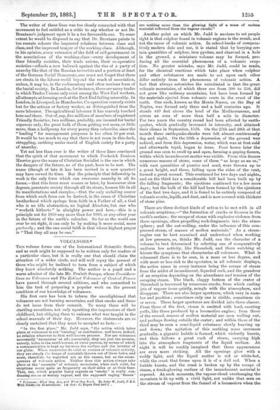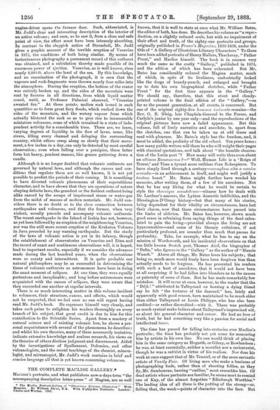VOLCANOES.* Tins volume forms one of the International Scientific Series,
and as such might be supposed to be written only for readers of a particular class, but it is really one that should claim the attention of a wider circle, and will well repay the perusal of those who might be inclined to turn from a subject of which they knew absolutely nothing. The author is a pupil and a
warm admirer of the late Mr. Poulett Scrope, whose Considera- time on Volcanoes and The Extinct Volcanoes of Central Prance have passed through several editions, and who committed to him the task of preparing a popular work on the present
condition of our knowledge of volcanoes.
His first care has been to inform the unenlightened that
volcanoes are not burning mountains, and that smoke and flame do not issue from their summit. To many these will be
startling assertions, not only upsetting the impressions of their childhood, but obliging them to unlearn what was taught in the school manuals of their day. However, the statements are so clearly sustained that they must be accepted as facts :—
" In the first place," Mr. Judd says, "the action which takes place at volcanoes is not' burning,' or combustion, and bears, indeed, no relation whatever to that well-known process. Nor are volcanoes necessarily mountains' at all ; essentially, they are just the reverse, namely, holes in the earth's crust, or outer portion, by means of which a communication is kept up between the surface and the interior of our globe. When mountains do exist at centres of volcanic activity, they are simply the heaps of materials thrown out of these holes, and must, therefore, be regarded not as the causes, but as the conse- quences of volcanic action. Neither duos this action always take place at the summits' of volcanic mountains, when such exist, for eruptions occur quite as frequently on their sides or at their base. That, too, which popular fancy regards as smoke ' is really con- densing ate im or watery vapour, and the supposed raging flames' • Volcanoes: What they Are, and What they Teach. By John W. Judd, P.R.B. With Ninety-six Illustration& lo don : C. Kagan Paul and C
are nothing more than the glowing light of a mass of molten material reflected from the vapour clouds."
Another point on which Mr. Judd is anxious to set people right is that sulphur found in volcanic regions is the result, and not the cause of volcanic action. In school-books of compara- tively modern date and use, it is stated that by burying cer- tain quantities of sulphur, iron pyrites, and charcoal in a hole in the ground, a miniature volcano may be formed, pro- ducing all the essential phenomena of a volcanic erup- tion. No greater mistake, says Mr. Judd, could be made, for the chemical reactions which take place when sulphur and other substances are made to act upon each other differ entirely from the phenomena of volcanic action. A fact that always astonishes the uninitiated is that the great volcanic mountains, of which there are from 300 to 350, did not grow like ordinary mountains, but have been formed by the materials ejected from volcanic vents in the crust of the earth. One such, known as the Monte Nuovo, on the Bay of Naples, was formed only three and a half centuries ago. It stands 440 feet above the level of the Mediterranean, and covers an area of more than half a mile in diameter. For two years the country round had been affected by earth. quakes, which gradually increased in intensity, and attained their climax in September, 1538. On the 27th and 28th of that month these earthquake-shocks were felt almost continuously day and night. On the 29th a depression of the ground was noticed, and from this depression, water, which was at first cold and afterwards tepid, began to issue. Four hours later the ground was seen to swell up and open, forming a gaping fissure, within which incandescent matter was visible. From this fissure numerous masses of stone, some of them " as large as an ox," with vast quantities of pumice and mud, were thrown up to a great height, and these, falling upon the sides of the vent, formed a great mound. This continued for two days and nights, and on the third day a considerable hill had been built up by the falling fragments ; the ejections continued for a few more days ; but the bulk of the hill had been formed by the ejections of the first two days, and it is found to be entirely composed of volcanic scoriae, lapilli, and dust, and is now covered with thickets of stone pine.
There are three distinct kinds of action to he met with in all volcanic eruptions,—" the formation of cracks or fissures in the earth's surface ; the escape of steam with explosive violence from these openings, often propelling rock-fragments into the atmo- sphere ; and the out-welling, under the influence of this com- pressed steam, of masses of molten materials." As a steam- engine can be best examined and understood when working at low pressure, so, thinks Mr. Judd, can the character of a volcano be best determined by selecting one of comparatively uniform low activity, like Stromboli, and there watching at leisure the symptoms that characterise all volcanoes. What is witnessed there is to be seen, in a more or less degree, and with more or less risk to the spectator, in all volcanic displays, the active cause in every instance being the escape of steam from the midst of incandescent, liquefied rock, and the grandeur of an eruption depending on the abundance and tension of the escaping steam. The black, slaggy bottom of the crater of Stromboli is traversed by numerous cracks, from which curling jets of vapour issue quietly, mingle with the atmosphere, and disappear. There are also larger apertures, which vary in num- ber and position ; sometimes only one is visible, sometimes six or seven. These larger apertures are divided into three classes. From those of the first, steam is emitted with loud, snorting puffs, like those produced by a locomotive engine; from those of the second, masses of molten material are seen welling out, and perhaps flowing outside the crater ; and within those of the third may be seen a semi-liquid substance slowly heaving up and down; the agitation of this seething mass increases gradually, a gigantic bubble is formed, which violently bursts, and then follows a great rush of steam, carrying high into the atmosphere fragments of the liquid surface. At night it will be readily imagined that these appearances are even more striking. All the openings glow with a ruddy light, and the liquid matter is red or white-hot, while the crust that forms upon it is of a dull red. When a bubble bursts, and the crust is broken up by the escape of steam, a fresh-glowing surface of the incandescent material is exposed. At such moments, the vapour-cloud overhanging the mountain is lit np with a vivid light, not unlike that seen on the stream of vapour from the funnel of a locomotive when the
engine-driver opens the furnace door. Such, abbreviated, is Mr. Judd's clear and interesting description of the interior of an active volcano ; and seen, as he saw it from a close and safe point of view, the effect must have been intensely absorbing. In contrast to the sluggish action of Stromboli, Mr. Judd gives a graphic account of the terrible eruption of Vesuvius in 1872, the conditions of both being similar. By means of instantaneous photography a permanent record of this outburst was obtained, and a calculation thereby made possible of its enormous power of ejection. Vesuvius, as is well known, rises nearly 4,000 ft. above the level of the sea. By this knowledge, and an examination of the photograph, it is seen that the vapours and rock-fragments were thrown nearly four miles into the atmosphere. During the eruption, the bottom of the crater was entirely broken up, and the sides of the mountain were rent by fissures in all directions, from which liquid matter oozed, until, as Professor Palmieri observed, " Vesuvius sweated fire." At three points, molten rock issued in such quantities as to form great fiery floods, which rushed down the sides of the mountain, and the watery vapour from which actually blistered the rock so as to give rise to innumerable miniature volcanoes, some of which remained in a state of inde- pendent activity for a considerable time. There are, we learn, varying degrees of liquidity in the flow of lavas, some, like rivers, filling every channel and deluging the surrounding country, whilst others creep along so slowly that their move- ment, a few inches in a day, can only be detected by most careful observation ; even when falling over a precipice, these latter form but heavy, pendent masses, like grease guttering down a candle.
Although it is no longer doubted that volcanic outbursts are governed by natural laws, and although the causes and con- ditions that regulate them are so well known, it is not yet possible to predict the periods of their coming. It is something to have divested volcanic phenomena of their superstitious character, and to have shown that they are operations of nature obeying definite laws, the grandest or the feeblest outburst being alike caused by the escape of imprisoned steam or water-gas from the midst of masses of molten materials. Mr. Judd con- siders there is no doubt as to the close connection between earthquakes and volcanoes, and that the former, when very violent, usually precede and accompany volcanic outbursts- The recent earthquake in the Island of Ischia has not, however, as yet been followed by an eruption of the neighbouring Vesuvius, nor was the still more recent eruption of the Krakatoa Volcano in Java preceded by any warning earthquake. But the study of the laws of volcanic action is yet in its infancy, though the establishment of observatories on Vesuvius and Etna and the record of exact and continuous observations will, it is hoped, lead to important results, especially if we consider the advances made during the last hundred years, when the observations were so scanty and intermittent. It is quite probable our natural philosophers may be as successful in determining the times of volcanic outbursts as astronomers have been in fixing the exact moment of eclipses. At one time, they were equally portentous and inexplicable ; .and long before astronomers were acquainted with the causes of eclipses, they were aware that they succeeded one another at regular intervals.
There is so much interesting matter in this volume incident to volcanoes, their structure, causes, and effects, which would not be suspected, that we feel sure no one will regret having read Mr. Judd's book. He expresses himself very clearly, and takes such pains to enlighten his readers thoroughly on every branch of his subject, that great credit is due to him for this contribution to the Scientific Series. Apart from a mastery of natural science and of existing volcanic lore, he shows a per- sonal acquaintance with several of the phenomena he describes ; and whilst his own theories, many of them necessarily tentative, indicate extensive knowledge and zealous research, his views on the theories of others disclose judgment and discernment. Aided by the investigations of Spallanzsni, Dolomieu, and other vulcanologists, and the recent teachings of the chemist, minera- logist, and microscopist, Mr. Judd's work contains in brief and concise language all that is yet known concerning volcanoes.



































 Previous page
Previous page